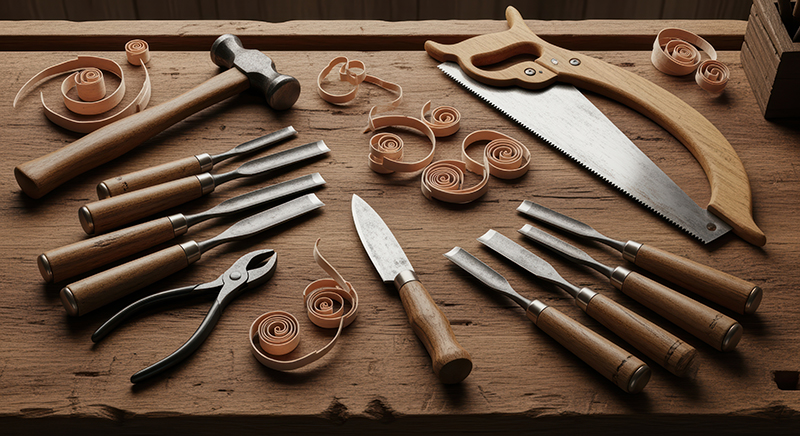Christopher Thigpen observers frequently note how the same wrist snap that drives a 6mm gouge through hard maple also powers a 5-weight rod through a 60-foot cast. Woodcarving and fly casting converge in biomechanical precision, controlled torque, sequential muscle firing, and proprioceptive feedback. This analysis dissects the kinetic chain of the gouge stroke and maps it onto the casting arc, revealing how shop-honed mechanics elevate line speed, loop shape, and distance accuracy. These principles transform carving practice into a fly-fishing laboratory.
Both disciplines demand micro-dosed power delivered through a rigid tool, gouge, or rod, where millimeter errors compound into failure. The body becomes the engine; the medium (wood or air) becomes the canvas.
Grip Architecture: The Foundation of Torque Transfer
Grip in carving and casting functions as the force transmission hub. A three-finger carving hold mirrors the thumb-on-top casting grip; both maximize leverage while minimizing tremor.
Optimal grip alignment ensures energy flows without leakage.
- Thumb-index V-lock: The carving thumb rests along the blade ferrule, forming a 30° V with the index finger; in casting, the thumb sits atop the cork at 45° to the rod blank. This V-channel wrist snap into linear force prevents rotational wobble that shears wood fibers or collapses the fly line loop.
- Pinky-ring anchor: The lower two fingers clamp the handle base, creating a stable fulcrum; in casting, they cinch the reel seat to counter rod torque. EMG studies show this anchor reduces grip pressure variability by 60%, critical for consistent gouge depth and casting plane.
- Neutral wrist preload: Both grips preload the wrist in slight flexion (10–15°), storing elastic energy for release. Over-extension fatigues the flexor carpi; under-extension collapses power. Carvers maintain this for hours; casters replicate it for 80 casts per outing.
Grip mastery sets the stage for sequential joint loading, the kinetic whip that defines both crafts.
Sequential Joint Loading: The Kinetic Whip Unveled
The gouge stroke and casting stroke follow an identical proximal-to-distal sequence: shoulder → elbow → wrist → tool tip. This chain stores and releases energy like a cracked whip.
Timing errors at any joint disrupt the entire system, splintered cuts or tangled leaders.
- Shoulder initiation (0–30°): The carving shoulder retracts 15° to load the latissimus dorsi; the casting shoulder rotates externally to load the same muscle for the backcast. Motion-capture data reveals 0.1-second overlap in activation, too early, and power leaks; too late, and the chain stalls.
- Elbow extension (30–70°): The carver’s elbow extends 40° to transfer momentum through the forearm; the caster’s elbow drives forward 50° to accelerate the rod butt. Both movements occur in the sagittal plane, lateral drift introduces “tailing loops” in air or “tear-out” in wood.
- Wrist snap (70–100°): Final 30° of wrist flexion unleashes stored energy, gouge tip accelerates to 3 m/s; rod tip to 25 m/s. High-speed video shows peak velocity at 90% extension; premature release skulls the cast; delayed release buries the blade.
This sequence, drilled in the shop, becomes muscle memory on the water. Proprioceptive feedback refines the loop.
Proprioceptive Feedback: The Silent Coach
Carving provides instant tactile data, vibration, resistance, and sound. Casting provides visual and auditory data, line loop, rod load, and splash. Both train the nervous system to self-correct.
Feedback loops close in under 200ms, faster than conscious thought.
- Vibration signature mapping: A gouge cutting end grain vibrates at 80 Hz; long grain at 40 Hz. Carvers adjust the angle within one stroke to smooth the signal. Casters feel rod load through the cork, tight loop (100 Hz) vs. open loop (60 Hz), and tweak wrist path mid-cast.
- Resistance gradient sensing: Wood density increases 20% near knots; carvers ease pressure to avoid fracture. Water resistance increases with line speed; casters ease into the stop to avoid collapse. Both read force curves through the handle.
- Auditory cues: A clean gouge cut produces a crisp “snick”; a clean cast produces a sharp “whoosh.” Deviations, dull thuds or windy howls trigger micro-corrections before the next cycle.
Shop feedback trains the caster’s internal metronome, turning practice into precision.
Tool Path Geometry: From Curve to Cast
The gouge follows a parabolic arc, shallow entry, deep center, shallow exit. The fly rod follows the same: 10-to-2 plane with a curved power snap.
Geometry dictates outcome, whether shaving basswood or shooting line.
- Entry angle (10–20°): The gouge skims to avoid diving; the rod tip dips to load. Both prevent “fat” contact, buried blade or collapsed loop.
- Apex depth/speed: Maximum gouge depth (3–5mm) occurs at 60% arc; maximum rod speed at 80% forward stroke. Timing misalignment drops efficiency by 40%.
- Exit taper: The gouge lifts to feather the cut; the rod stops abruptly to form the loop. Both create clean release, no hanging fibers, and no trailing loops.
Path mastery, carved in wood, casts on water. Drills bridge the gap.
Cross-Disciplinary Drills: Shop to Stream Translation
Integrate carving into casting practice with these hybrid sequences.
From bench to backyard, alternate 10 gouge strokes (same grip, same plane) with 10 dry casts, no line, just rod. Match wrist snap tempo. After shop to casting platform, carve a 2-inch curve in pine, then cast to a 2-foot hoop at 40 feet, focus on parabolic path. Between studio and lawn, use a carving mallet to tap a yarn ball, mimic rod stop timing, then cast the yarn 30 feet.
These loops build neuromuscular synergy, reducing on-water variables.
The Mental Parallel: Flow State in Two Mediums
Carving enters flow when the gouge becomes an extension of intent, and wood yields without resistance. Casting enters flow when the rod disappears, line unrolls in perfect geometry.
Both demand present-moment focus: anticipate, execute, release, repeat. The shop teaches process detachment; a chipped cut is sanded, and a wind knot is retied. The river demands the same.
A single gouge stroke and a single cast, separated by years of practice, united by biomechanics.
